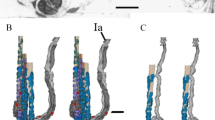Summary
The thoracic-coxal muscle receptor organ (T-C MRO) in crabs mediates concurrent reflex excitation (positive feedback) and inhibition (negative feedback) of the one of its two motoneurones with the greater contractile effect on the receptor muscle (RM), viz. the specific receptor motoneurone, Rm1 (analogous to mammalian γ motoneurones).
-
1.
In most preparations the tonic firing frequency of Rm1 declines progressively with increasing RM length over the physiological range (Figs. 1–3).
-
2.
Selectively ablating the displacement sensitive afferent, the S fibre, or damaging its membrane, reverses this RM length-dependent tonic decline, and enhances the dynamic Rm1 response to receptor stretch (Fig. 4).
-
3.
Conversely, ablation of the tension-sensitive T fibre abolishes, and T fibre membrane damage reduces, the Rm1 reflex response to receptor stretch.
-
4.
Intracellular injection of constant current pulses confirms the excitatory drive of Rm1 by the T fibre and the inhibitory influence of the S fibre. Thus while depolarisation of the T fibre excites Rm1, S fibre depolarisation inhibits it; conversely hyperpolarisation of the T fibre abolishes ongoing tonic activity whereas S fibre hyperpolarisation (at extended RM lengths) enhances tonic activity of Rm1 (Figs. 5, 6).
-
5.
Ramp-function 1 mm stretches of constant velocity applied at different RM lengths over the full in vivo range of 5 mm result in invariant Rm1 dynamic reflex frequencies. The dynamic positive feedback reflex is thus stabilized with respect to RM length (Fig. 8).
-
6.
Experiments involving current-induced S fibre hyperpolarisation concurrent with rampfunction stretch stimuli, demonstrate unequivocally the inhibitory role of the S fibre in effecting this dynamic reflex stabilization (Fig. 9).
-
7.
The small dynamic sensitivity of the S fibre (Table 1) does not significantly affect the reflex expression of T fibre dynamic responsiveness, so that Rm1 reflex output remains a direct function of the logarithm of stretch velocity at any given initial RM length (Figs. 7, 9).
Similar content being viewed by others
Abbreviations
- Pm :
-
promotor muscle motoneurone
- Rm :
-
receptor motoneurone
- RM :
-
receptor muscle
- T-C MRO :
-
thoraciccoxal muscle receptor organ
References
Alexandrowicz JS, Whitear M (1957) Receptor elements in the coxal region of Decapoda Crustacea. J Mar Biol Assoc UK 36:603–628
Berger CS, Bush BMH (1979) A non-linear mechanical model of a non-spiking muscle receptor. J Exp Biol 83:339–343
Blight AR, Llinás R (1980) The non-impulsive stretch-receptor complex of the crab — a study of depolarization-release coupling at a tonic sensorimotor synapse. Philos Trans R Soc Lond [Biol] 290:219–276
Bush BMH (1976) Non-impulsive thoracic-coxal receptors in crustaceans. In: Mill PJ (ed) Structure and function of proprioceptors in the invertebrates. Chapman and Hall, London, pp 115–151
Bush BMH (1981) Non-impulsive stretch receptors in crustaceans. In: Roberts A, Bush BMH (eds) Neurones without impulses. Cambridge University Press, Cambridge, pp 147–176
Bush BMH, Laverack MS (1982) Mechanoreception. In: Atwood HL, Sandeman DC (eds) The biology of Crustacea, vol 3, Neural integration. Academic Press, New York, pp 399–467
Bush BMH, Roberts A (1971) Coxal muscle receptors in the crab: the receptor potentials of S and T fibres in response to ramp stretches. J Exp Biol 55:813–832
Bush BMH, Godden DH, Macdonald GA (1975) A simple and inexpensive servo system for the control of length or tension of small muscles or stretch receptors. J Physiol 245:1P-3P
Cannone AJ, Bush BMH (1980a) Reflexes mediated by nonimpulsive afferent neurones of thoracic-coxal muscle receptor organs in the crabCarcinus maenas. I. Receptor potentials and promotor motoneurone responses. J Exp Biol 86:275–303
Cannone AJ, Bush BMH (1980b) Reflexes mediated by nonimpulsive afferent neurones of thoracic-coxal muscle receptor organs in the crabCarcinus maenas. II. Reflex discharge evoked by current injection. J Exp Biol 86:305–331
Cannone AJ, Bush BMH (1981a) Reflexes mediated by nonimpulsive afferent neurones of thoracic-coxal muscle receptor organs in the crab,Carcinus maenas. III. Positive feedback to the receptor muscle. J Comp Physiol 142:103–112
Cannone AJ, Bush BMH (1981b) Reflexes mediated by nonimpulsive afferent neurones of thoracic-coxal muscle receptor organs in the crab,Carcinus maenas. IV. Motor activation of the receptor muscle. J Comp Physiol 142:113–125
Cannone A, Bush BMH (1981c) Positive feedback to a muscle receptor stabilized by concurrent self-inhibition. Brain Res 229:197–202
Evoy WH (1976) Modulation of proprioceptive information in Crustacea. In: Herman RM, Grillner S, Stein PSG, Stuart DG (eds) Neural control of locomotion. Plenum Press, New York London, pp 617–645
Kennedy D, Davis WJ (1977) Organization of invertebrate motor systems. In: Geiger SR, Kandel ER, Brookhart JM, Mountcastle VB (eds) Handbook of physiology, sect 1, vol 1/2. Am Physiol Soc, Bethesda, Maryland, pp 1023–1087
Matthews PBC (1981) Evolving views on the internal operation and functional role of the muscle spindle. J Physiol 320:1–30
Mill PJ (1976) Chordotonal organs of crustacean appendages. In: Mill PJ (ed) Structure and function of proprioceptors in the invertebrates. Chapman and Hall, London, pp 243–297
Mirolli M (1979) The electrical properties of a crustacean sensory dendrite. J Exp Biol 78:1–27
Mirolli M (1981) Fast inward and outward current channels in a non-spiking neurone. Nature 292:251–253
Murthy KSK (1978) Vertebrate fusimotor neurones and their influences on motor behavior. Prog Neurobiol 11:249–307
Pringle JWS (1961) Proprioception in arthropods. In: Ramsay JA, Wigglesworth VB (eds) The cell and the organism. Cambridge University Press, Cambridge, pp 256–282
Taylor A, Prochazka A (1981) (eds) Muscle receptors and movement. Macmillan, London
Author information
Authors and Affiliations
Rights and permissions
About this article
Cite this article
Cannone, A., Bush, B.M.H. Dual reflex motor control of non-spiking crab muscle receptor. J. Comp. Physiol. 148, 365–377 (1982). https://doi.org/10.1007/BF00679021
Accepted:
Issue Date:
DOI: https://doi.org/10.1007/BF00679021




